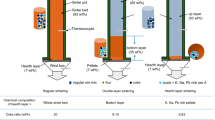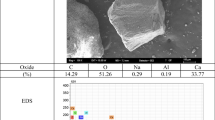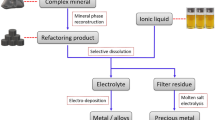Abstract
Over 60 million tons of aluminium are produced annually, requiring sustainable and eco-friendly recycling methods of aluminium waste. In this work, aluminium metal waste is utilized in the fabrication of aluminium hydroxide aerogels using a cost-effective and environmental-friendly process. The developed aerogels with varying contents of aluminium and poly(vinyl alcohol) as a binder exhibit a low density (0.060–0.108 g/cm3), a high porosity (92.3–95.5%) and a low electrical conductivity ([1.8–5.2] × 10–8 S/m). The results indicated that aluminium hydroxide aerogels have an ultra-low thermal conductivity of 0.028–0.032 W/m K and are able to withstand high temperature of 800 °C with less than 50% decomposition. It is suggested that the synthesized aerogels can be a promising candidate for high-value engineering applications such as thermal insulation of pipes and buildings to expand the usage of recycled aluminium.





Similar content being viewed by others
Change history
19 March 2021
A Correction to this paper has been published: https://doi.org/10.1007/s10163-021-01211-w
References
Maher JP (1997) Aluminium, gallium, indium and thallium. Annu Rep Prog Chem Sect A. https://doi.org/10.1039/ic9969300045
Fröhlich P, Lorenz T, Martin G, Brett B, Bertau M (2017) Valuable metals—recovery processes, current trends, and recycling strategies. Angew Chem Int Ed. https://doi.org/10.1002/anie.201605417
Yash D, Prasad E (2019) Aluminum market by end user, processing method and series - global opportunity analysis and industry forecast, 2019–2026
Ab-Rahim SN, Lajis MA, Ariffin S (2015) A review on recycling aluminum chips by hot extrusion process. Procedia CIRP. https://doi.org/10.1016/j.procir.2015.01.013
Bertram M, Ramkumar S, Rechberger H, Rombach G, Bayliss C, Martchek KJ, Müller DB, Liu G (2017) A regionally-linked, dynamic material flow modelling tool for rolled, extruded and cast aluminium products. Resour Conserv Recycl 125:48–69. https://doi.org/10.1016/j.resconrec.2017.05.014
Schlesinger ME (1983) Aluminium-recycling. CRC Press, Boca Raton
Güley V, Ben-Khalifa N, Tekkaya AE (2010) Direct recycling of 1050 aluminum alloy scrap material mixed with 6060 aluminum alloy chips by hot extrusion. Int J Mater Form. 3:853–856. https://doi.org/10.1007/s12289-010-0904-z
Wuebbles DS, Tamaresis JS (1993) The role of methane in the global environment. In: Atmos Methane Sources, Sink. Role Glob. Chang. Springer Berlin Heidelberg, Berlin, pp. 469–513. https://doi.org/https://doi.org/10.1007/978-3-642-84605-2_20.
Xiao Y, Reuter MA, Boin U (2005) Aluminium recycling and environmental issues of salt slag treatment. J Environ Sci Heal Part A Toxic/Hazardous Subst Environ Eng. https://doi.org/10.1080/10934520500183824
Soo VK, Peeters J, Paraskevas D, Compston P, Doolan M, Duflou JR (2018) Sustainable aluminium recycling of end-of-life products: a joining techniques perspective. J Clean Prod 178:119–132. https://doi.org/10.1016/j.jclepro.2017.12.235
Grimaud G, Perry N, Laratte B (2018) Aluminium cables recycling process: environmental impacts identification and reduction. Resour Conserv Recycl 135:150–162. https://doi.org/10.1016/j.resconrec.2017.11.010
Shamsudin S, Lajis M, Zhong ZW (2016) Evolutionary in solid state recycling techniques of aluminium: a review. Procedia CIRP. https://doi.org/10.1016/j.procir.2016.01.117
Technavio Research, Global Aluminum Foil Market 2020–2024, (2020). https://www.technavio.com/. Accessed 20 Apr 2020
Ratke, B. Milow (2011) Aerogels for foundry applications. In: Aerogels Handbook. Springer New York, pp 763–788. https://doi.org/https://doi.org/10.1007/978-1-4419-7589-8_34
De France KJ, Hoare T, Cranston ED (2017) Review of hydrogels and aerogels containing nanocellulose. Chem Mater 29:4609–4631. https://doi.org/10.1021/acs.chemmater.7b00531
Tao Y, Endo M, Kaneko K (2010) A review of synthesis and nanopore structures of organic polymer aerogels and carbon aerogels. Recent Patents Chem Eng 1:192–200. https://doi.org/10.2174/1874478810801030192
Gurav JL, Jung IK, Park HH, Kang ES, Nadargi DY (2010) Silica aerogel: synthesis and applications. J Nanomater 2010:409310. https://doi.org/10.1155/2010/409310
Zhao W, Zhu J, Wei W, Ma L, Zhu J, Xie J (2018) Comparative study of modified/non-modified aluminum and silica aerogels for anionic dye adsorption performance. RSC Adv 8:29129–29140. https://doi.org/10.1039/c8ra05532g
Yang W, Dou X, Li Y, Mohan D, Pittman CU, Ok YS (2016) Performance and mass transfer of aqueous fluoride removal by a magnetic alumina aerogel. RSC Adv 6:112988–112999. https://doi.org/10.1039/c6ra23532h
Hou X, Zhang R, Fang D (2017) Novel whisker-reinforced Al2O3–SiO2 aerogel composites with ultra-low thermal conductivity. Ceram Int 43:9547–9551. https://doi.org/10.1016/j.ceramint.2017.04.043
Gao B, Yuan G, Ren L (2018) Polydiacetylene-functionalized alumina aerogels as visually observable sensing materials for detecting VOCs concentration. J Mater Sci 53:6698–6706. https://doi.org/10.1007/s10853-018-1988-y
Yang J, Wang Q, Wang T, Liang Y (2017) Facile one-step precursor-to-aerogel synthesis of silica-doped alumina aerogels with high specific surface area at elevated temperatures. J Porous Mater 24:889–897. https://doi.org/10.1007/s10934-016-0328-3
Mei J, Yuan G, Bai J, Ma Y, Ren L (2019) One-pot synthesis of bimetallic catalyst loaded on alumina aerogel as green heterogeneous catalyst: efficiency, stability, and mechanism. J Taiwan Inst Chem Eng 101:41–49. https://doi.org/10.1016/j.jtice.2019.04.033
Le DK, Leung RIH, Er ASR, Zhang X, Tay XJ, Thai QB, Phan-Thien N, Duong HM (2019) Applications of functionalized polyethylene terephthalate aerogels from plastic bottle waste. Waste Manag 100:296–305. https://doi.org/10.1016/j.wasman.2019.09.031
Ba-Thai Q, Ee-Siang T, Khac-Le D, Shah WA, Phan-Thien N, Duong HM (2019) Advanced fabrication and multi-properties of rubber aerogels from car tire waste. Colloids Surf A Physicochem Eng Asp 577:702–708. https://doi.org/10.1016/j.colsurfa.2019.06.029
Cheng H, Gu B, Pennefather MP, Nguyen TX, Phan-Thien N, Duong HM (2017) Cotton aerogels and cotton-cellulose aerogels from environmental waste for oil spillage cleanup. Mater Des 130:452–458. https://doi.org/10.1016/j.matdes.2017.05.082
Do NHN, Luu TP, Thai QB, Le DK, Chau NDQ, Nguyen ST, Le PK, Phan-Thien N, Duong HM (2020) Advanced fabrication and application of pineapple aerogels from agricultural waste. Mater Technol 35:807–814. https://doi.org/10.1080/10667857.2019.1688537
Yam BJY, Le DK, Do NH, Nguyen PTT, Thai QB, Phan-Thien N, Duong HM (2020) Recycling of magnesium waste into magnesium hydroxide aerogels. J Environ Chem Eng 8:104101. https://doi.org/10.1016/j.jece.2020.104101
Thai QB, Nguyen ST, Ho DK, Du Tran T, Huynh DM, Do NHN, Luu TP, Le PK, Le DK, Phan-Thien N, Duong HM (2020) Cellulose-based aerogels from sugarcane bagasse for oil spill-cleaning and heat insulation applications. Carbohydr Polym. https://doi.org/10.1016/j.carbpol.2019.115365
Zhang X, Kwek LP, Le DK, Tan MS, Duong HM (2019) Fabrication and properties of hybrid coffee-cellulose aerogels from spent coffee grounds. Polymers (Basel). https://doi.org/10.3390/polym11121942
Thai QB, Le DK, Luu TP, Hoang N, Nguyen D, Duong HM (2019) Aerogels from wastes and their applications fabrication methods and morphologies of aerogels from wastes cellulose aerogels from paper waste cotton aerogels from textile waste. JOJ Mater Sci 5:1–5. https://doi.org/10.19080/JOJMS.2019.05.555663
Shen D, Liu J, Gan L, Huang N, Long M (2018) Green synthesis of Fe3O4/cellulose/polyvinyl alcohol hybride aerogel and its application for dye removal. J Polym Environ 26:2234–2242. https://doi.org/10.1007/s10924-017-1116-0
Xu Z, Jiang X, Zhou H, Li J (2018) Preparation of magnetic hydrophobic polyvinyl alcohol (PVA)–cellulose nanofiber (CNF) aerogels as effective oil absorbents. Cellulose 25:1217–1227. https://doi.org/10.1007/s10570-017-1619-9
Kang AH, Shang K, Ye DD, Wang YT, Wang H, Zhu ZM, Liao W, Xu SM, Wang YZ, Schiraldi DA (2017) Rejuvenated fly ash in poly(vinyl alcohol)-based composite aerogels with high fire safety and smoke suppression. Chem Eng J 327:992–999. https://doi.org/10.1016/j.cej.2017.06.158
Goudarzi M, Ghanbari D, Salavati-Niasari M (2015) Room temperature preparation of aluminum hydroxide nanoparticles and flame retardant poly vinyl alcohol nanocomposite. J Nanostruct 5(2):110–115. https://doi.org/10.7508/jns.2015.02.005
Lamberti M, Escher F (2007) Aluminium foil as a food packaging material in comparison with other materials. Food Rev Int 23:407–433. https://doi.org/10.1080/87559120701593830
Zou Q, Li J, Li Y (2015) Preparation and characterization of vanillin-crosslinked chitosan therapeutic bioactive microcarriers. Int J Biol Macromol 79:736–747. https://doi.org/10.1016/j.ijbiomac.2015.05.037
González-Gómez MA, Belderbos S, Yañez-Vilar S, Piñeiro Y, Cleeren F, Bormans G, Deroose CM, Gsell W, Himmelreich U, Rivas J (2019) Development of superparamagnetic nanoparticles coated with polyacrylic acid and aluminum hydroxide as an efficient contrast agent for multimodal imaging. Nanomaterials 9:1626. https://doi.org/10.3390/nano9111626
González-Gómez MA, Belderbos S, Yañez-Vilar S, Piñeiro Y, Cleeren F, Bormans G, Deroose CM, Gsell W, Himmelreich U, Rivas J (2019) Development of superparamagnetic nanoparticles coated with polyacrylic acid and aluminum hydroxide as an efficient contrast agent for multimodal imaging. Nanomaterials. https://doi.org/10.3390/nano9111626
Lei Z, Li X, Li Z, Qu J, Zhang Q, Huang J, Li H (2017) Potassium fixation and the separation from sodium through the formation of K-alunite using activated aluminum hydroxide. Sep Sci Technol 52:1862–1868. https://doi.org/10.1080/01496395.2017.1304418
Mansur HS, Sadahira CM, Souza AN, Mansur AAP (2008) FTIR spectroscopy characterization of poly (vinyl alcohol) hydrogel with different hydrolysis degree and chemically crosslinked with glutaraldehyde. Mater Sci Eng C 28:539–548. https://doi.org/10.1016/j.msec.2007.10.088
Lemmon EW, Jacobsen RT (2004) Viscosity and thermal conductivity equations for nitrogen, oxygen, argon, and air. Int J Thermophys 25:21–69. https://doi.org/10.1023/B:IJOT.0000022327.04529.f3
Sumirat I, Ando Y, Shimamura S (2006) Theoretical consideration of the effect of porosity on thermal conductivity of porous materials. J Porous Mater 13:439–443. https://doi.org/10.1007/s10934-006-8043-0
Hrubesh LW, Pekala RW (1994) Thermal properties of organic and inorganic aerogels. J Mater Res 9:731–738. https://doi.org/10.1557/jmr.1994.0731
Jelle BP, Baetens R, Gustavsen A (2015) Aerogel insulation for building applications. In: Sol-Gel Handbook. Wiley Blackwell, pp. 1385–1412. https://doi.org/https://doi.org/10.1002/9783527670819.ch45
Nguyen ST, Feng J, Ng SK, Wong JPW, Tan VBC, Duong HM (2014) Advanced thermal insulation and absorption properties of recycled cellulose aerogels. Colloids Surf A Physicochem Eng Asp 445:128–134. https://doi.org/10.1016/j.colsurfa.2014.01.015
Feng J, Le D, Nguyen ST, Tan Chin Nien V, Jewell D, Duong HM (2016) Silica–cellulose hybrid aerogels for thermal and acoustic insulation applications. Colloids Surf A Physicochem Eng Asp 506:298–305. https://doi.org/10.1016/j.colsurfa.2016.06.052
Jia X, Dai B, Zhu Z, Wang J, Qiao W, Long D, Ling L (2016) Strong and machinable carbon aerogel monoliths with low thermal conductivity prepared via ambient pressure drying. Carbon N Y 108:551–560. https://doi.org/10.1016/j.carbon.2016.07.060
Gomaa MM, Hugenschmidt C, Dickmann M, Abdel-Hady EE, Mohamed HFM, Abdel-Hamed MO (2018) Crosslinked PVA/SSA proton exchange membranes: correlation between physiochemical properties and free volume determined by positron annihilation spectroscopy. Phys Chem Chem Phys 20:28287–28299. https://doi.org/10.1039/c8cp05301d
Strekopytov S, Exley C (2006) Thermal analyses of aluminium hydroxide and hydroxyaluminosilicates. Polyhedron 25:1707–1713. https://doi.org/10.1016/j.poly.2005.11.011
Yang H, Xu S, Jiang L, Dan Y (2012) Thermal decomposition behavior of poly (vinyl alcohol) with different hydroxyl content. J Macromol Sci Part B Phys 51:464–480. https://doi.org/10.1080/00222348.2011.597687
Chen I, Hwang SK, Chen S (1989) Chemical kinetics and reaction mechanism of thermal decomposition of aluminum hydroxide and magnesium hydroxide at high temperatures (973–1123 K). Ind Eng Chem Res 28:738–742. https://doi.org/10.1021/ie00090a015
Alhwaige AA, Herbert MM, Alhassan SM, Ishida H, Qutubuddin S, Schiraldi DA (2016) Laponite/multigraphene hybrid-reinforced poly(vinyl alcohol) aerogels. Polymer (Guildf) 91:180–186. https://doi.org/10.1016/j.polymer.2016.03.077
Wypych G (2016) Fillers—origin, chemical composition, properties, and morphology. In: Handbook of Fillers. Elsevier, pp. 13–266. https://doi.org/https://doi.org/10.1016/b978-1-895198-91-1.50004-x
Finlay KA, Gawryla MD, Schiraldi DA (2015) Effects of fiber reinforcement on clay aerogel composites. Materials (Basel) 8:5440–5451. https://doi.org/10.3390/ma8085258
Zheng Q, Cai Z, Gong S (2014) Green synthesis of polyvinyl alcohol (PVA)-cellulose nanofibril (CNF) hybrid aerogels and their use as superabsorbents. J Mater Chem A 2:3110–3118. https://doi.org/10.1039/c3ta14642a
Acknowledgements
The authors would like to thank Temasek Laboratories @ NUS, R-265-000-682-720 (Mapletree Gift), R-265-000-682-114 (MOE Tier 1 FRC), R-265-000-682-133 (ODPRT) and R-265-000-682-731 (ME) for the financial support for the financial support.
Author information
Authors and Affiliations
Corresponding author
Ethics declarations
Conflict of interest
There are no conflicts to declare.
Additional information
Publisher's Note
Springer Nature remains neutral with regard to jurisdictional claims in published maps and institutional affiliations.
Rights and permissions
About this article
Cite this article
Sp, T.S., Nguyen, P.T.T., Do, N.H.N. et al. Advanced fabrication and multi-properties of aluminium hydroxide aerogels from aluminium wastes. J Mater Cycles Waste Manag 23, 885–894 (2021). https://doi.org/10.1007/s10163-020-01169-1
Received:
Accepted:
Published:
Issue Date:
DOI: https://doi.org/10.1007/s10163-020-01169-1




